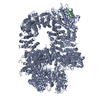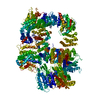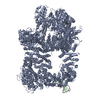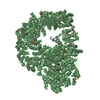+ Open data
Open data
- Basic information
Basic information
| Entry | Database: EMDB / ID: EMD-11006 | ||||||||||||||||||
|---|---|---|---|---|---|---|---|---|---|---|---|---|---|---|---|---|---|---|---|
| Title | Structure of human cGAS bound to the nucleosome | ||||||||||||||||||
 Map data Map data | |||||||||||||||||||
 Sample Sample |
| ||||||||||||||||||
| Biological species |  Homo sapiens (human) Homo sapiens (human) | ||||||||||||||||||
| Method | single particle reconstruction / cryo EM / Resolution: 5.1 Å | ||||||||||||||||||
 Authors Authors | Pathare GR / Cavadini S / Kempf G / Thoma NH | ||||||||||||||||||
| Funding support |  Switzerland, 5 items Switzerland, 5 items
| ||||||||||||||||||
 Citation Citation |  Journal: Nature / Year: 2020 Journal: Nature / Year: 2020Title: Structural mechanism of cGAS inhibition by the nucleosome. Authors: Ganesh R Pathare / Alexiane Decout / Selene Glück / Simone Cavadini / Kristina Makasheva / Ruud Hovius / Georg Kempf / Joscha Weiss / Zuzanna Kozicka / Baptiste Guey / Pauline Melenec / ...Authors: Ganesh R Pathare / Alexiane Decout / Selene Glück / Simone Cavadini / Kristina Makasheva / Ruud Hovius / Georg Kempf / Joscha Weiss / Zuzanna Kozicka / Baptiste Guey / Pauline Melenec / Beat Fierz / Nicolas H Thomä / Andrea Ablasser /  Abstract: The DNA sensor cyclic GMP-AMP synthase (cGAS) initiates innate immune responses following microbial infection, cellular stress and cancer. Upon activation by double-stranded DNA, cytosolic cGAS ...The DNA sensor cyclic GMP-AMP synthase (cGAS) initiates innate immune responses following microbial infection, cellular stress and cancer. Upon activation by double-stranded DNA, cytosolic cGAS produces 2'3' cGMP-AMP, which triggers the induction of inflammatory cytokines and type I interferons . cGAS is also present inside the cell nucleus, which is replete with genomic DNA, where chromatin has been implicated in restricting its enzymatic activity. However, the structural basis for inhibition of cGAS by chromatin remains unknown. Here we present the cryo-electron microscopy structure of human cGAS bound to nucleosomes. cGAS makes extensive contacts with both the acidic patch of the histone H2A-H2B heterodimer and nucleosomal DNA. The structural and complementary biochemical analysis also find cGAS engaged to a second nucleosome in trans. Mechanistically, binding of the nucleosome locks cGAS into a monomeric state, in which steric hindrance suppresses spurious activation by genomic DNA. We find that mutations to the cGAS-acidic patch interface are sufficient to abolish the inhibitory effect of nucleosomes in vitro and to unleash the activity of cGAS on genomic DNA in living cells. Our work uncovers the structural basis of the interaction between cGAS and chromatin and details a mechanism that permits self-non-self discrimination of genomic DNA by cGAS. | ||||||||||||||||||
| History |
|
- Structure visualization
Structure visualization
| Movie |
 Movie viewer Movie viewer |
|---|---|
| Structure viewer | EM map:  SurfView SurfView Molmil Molmil Jmol/JSmol Jmol/JSmol |
| Supplemental images |
- Downloads & links
Downloads & links
-EMDB archive
| Map data |  emd_11006.map.gz emd_11006.map.gz | 119 MB |  EMDB map data format EMDB map data format | |
|---|---|---|---|---|
| Header (meta data) |  emd-11006-v30.xml emd-11006-v30.xml emd-11006.xml emd-11006.xml | 22.5 KB 22.5 KB | Display Display |  EMDB header EMDB header |
| Images |  emd_11006.png emd_11006.png | 83.6 KB | ||
| Others |  emd_11006_additional.map.gz emd_11006_additional.map.gz emd_11006_additional_1.map.gz emd_11006_additional_1.map.gz | 114.5 MB 114.5 MB | ||
| Archive directory |  http://ftp.pdbj.org/pub/emdb/structures/EMD-11006 http://ftp.pdbj.org/pub/emdb/structures/EMD-11006 ftp://ftp.pdbj.org/pub/emdb/structures/EMD-11006 ftp://ftp.pdbj.org/pub/emdb/structures/EMD-11006 | HTTPS FTP |
-Validation report
| Summary document |  emd_11006_validation.pdf.gz emd_11006_validation.pdf.gz | 223.3 KB | Display |  EMDB validaton report EMDB validaton report |
|---|---|---|---|---|
| Full document |  emd_11006_full_validation.pdf.gz emd_11006_full_validation.pdf.gz | 222.4 KB | Display | |
| Data in XML |  emd_11006_validation.xml.gz emd_11006_validation.xml.gz | 7.2 KB | Display | |
| Arichive directory |  https://ftp.pdbj.org/pub/emdb/validation_reports/EMD-11006 https://ftp.pdbj.org/pub/emdb/validation_reports/EMD-11006 ftp://ftp.pdbj.org/pub/emdb/validation_reports/EMD-11006 ftp://ftp.pdbj.org/pub/emdb/validation_reports/EMD-11006 | HTTPS FTP |
-Related structure data
- Links
Links
| EMDB pages |  EMDB (EBI/PDBe) / EMDB (EBI/PDBe) /  EMDataResource EMDataResource |
|---|---|
| Related items in Molecule of the Month |
- Map
Map
| File |  Download / File: emd_11006.map.gz / Format: CCP4 / Size: 244.1 MB / Type: IMAGE STORED AS FLOATING POINT NUMBER (4 BYTES) Download / File: emd_11006.map.gz / Format: CCP4 / Size: 244.1 MB / Type: IMAGE STORED AS FLOATING POINT NUMBER (4 BYTES) | ||||||||||||||||||||||||||||||||||||||||||||||||||||||||||||||||||||
|---|---|---|---|---|---|---|---|---|---|---|---|---|---|---|---|---|---|---|---|---|---|---|---|---|---|---|---|---|---|---|---|---|---|---|---|---|---|---|---|---|---|---|---|---|---|---|---|---|---|---|---|---|---|---|---|---|---|---|---|---|---|---|---|---|---|---|---|---|---|
| Projections & slices | Image control
Images are generated by Spider. | ||||||||||||||||||||||||||||||||||||||||||||||||||||||||||||||||||||
| Voxel size | X=Y=Z: 0.68 Å | ||||||||||||||||||||||||||||||||||||||||||||||||||||||||||||||||||||
| Density |
| ||||||||||||||||||||||||||||||||||||||||||||||||||||||||||||||||||||
| Symmetry | Space group: 1 | ||||||||||||||||||||||||||||||||||||||||||||||||||||||||||||||||||||
| Details | EMDB XML:
CCP4 map header:
| ||||||||||||||||||||||||||||||||||||||||||||||||||||||||||||||||||||
-Supplemental data
-Additional map: Local-resolution filtered and sharpened map.
| File | emd_11006_additional.map | ||||||||||||
|---|---|---|---|---|---|---|---|---|---|---|---|---|---|
| Annotation | Local-resolution filtered and sharpened map. | ||||||||||||
| Projections & Slices |
| ||||||||||||
| Density Histograms |
-Additional map: Local-resolution filtered and sharpened map.
| File | emd_11006_additional_1.map | ||||||||||||
|---|---|---|---|---|---|---|---|---|---|---|---|---|---|
| Annotation | Local-resolution filtered and sharpened map. | ||||||||||||
| Projections & Slices |
| ||||||||||||
| Density Histograms |
- Sample components
Sample components
+Entire : Cryo EM structure of cGAS-NCP1 complex
+Supramolecule #1: Cryo EM structure of cGAS-NCP1 complex
+Supramolecule #2: Cryo EM structure of cGAS-NCP1 complex
+Supramolecule #3: DNA
+Macromolecule #1: Histone H3.2
+Macromolecule #2: Histone H4
+Macromolecule #3: Histone H2A type 2-C
+Macromolecule #4: Histone H2B type 1-K
+Macromolecule #5: DNA (153-MER)
+Macromolecule #6: DNA (153-MER)
+Macromolecule #7: Cyclic GMP-AMP synthase
-Experimental details
-Structure determination
| Method | cryo EM |
|---|---|
 Processing Processing | single particle reconstruction |
| Aggregation state | particle |
- Sample preparation
Sample preparation
| Concentration | 1 mg/mL |
|---|---|
| Buffer | pH: 7.4 / Component - Concentration: 300.0 mM / Component - Formula: NaCl / Component - Name: Sodium chloride |
| Grid | Model: Quantifoil R1.2/1.3 / Material: COPPER / Mesh: 1 / Pretreatment - Type: GLOW DISCHARGE / Pretreatment - Atmosphere: OTHER |
| Vitrification | Cryogen name: ETHANE |
- Electron microscopy
Electron microscopy
| Microscope | TFS GLACIOS |
|---|---|
| Temperature | Min: 77.0 K / Max: 77.0 K |
| Image recording | Film or detector model: FEI FALCON III (4k x 4k) / Detector mode: COUNTING / Number grids imaged: 3 / Number real images: 5007 / Average electron dose: 35.0 e/Å2 |
| Electron beam | Acceleration voltage: 200 kV / Electron source:  FIELD EMISSION GUN FIELD EMISSION GUN |
| Electron optics | Calibrated defocus min: 2.0 µm / Illumination mode: SPOT SCAN / Imaging mode: BRIGHT FIELD / Cs: 2.7 mm / Nominal defocus min: -0.0005 µm / Nominal magnification: 150000 |
| Sample stage | Specimen holder model: FEI TITAN KRIOS AUTOGRID HOLDER / Cooling holder cryogen: NITROGEN |
 Movie
Movie Controller
Controller



















 Z (Sec.)
Z (Sec.) Y (Row.)
Y (Row.) X (Col.)
X (Col.)






































